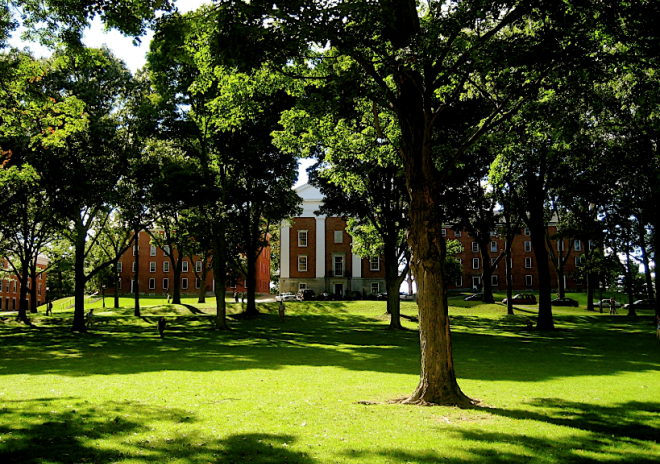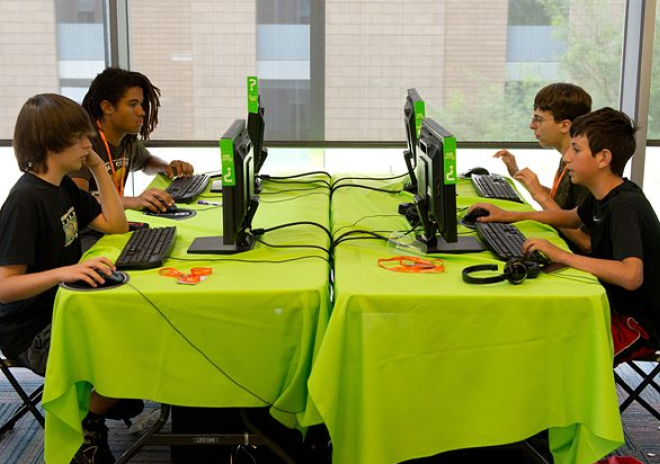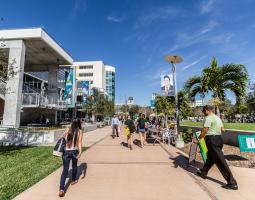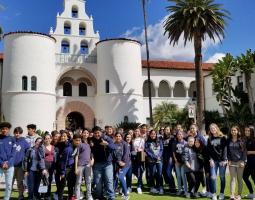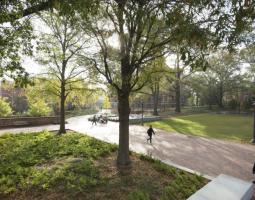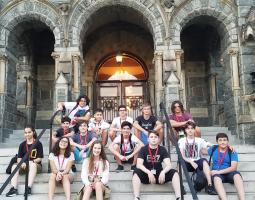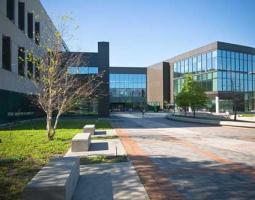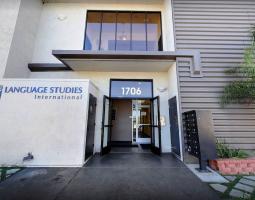Amherst College Summer Camp with programming
Programs and prices, tuition fees in Amherst College Summer Camp with programming
Roblox Entrepreneur: Imaginative Game Design
- Age of students: 10-12 years old
- Level of education: beginner-advanced
- Direction of studying: coding, game development, design, creativity
- Toolkit: Roblox, Roblox Studio.
Roblox is one of the fastest growing global gaming sites that is popular with thousands of people around the world, bringing millions of dollars to their developers every year. At the Roblox Entrepreneur: Imaginative Game Design program, students will learn to masterfully own the built-in Roblox editor, to create and publish games on various platforms, learn the basics of game design, get acquainted with top-end game products, learn how to apply some of those strategies in their own work.
At the end of the course, graduates receive an ID Tech diploma and an educational course entry.
Young students will learn to:
- Create games and publish them on Roblox
- The basics of programming with Lua
- Game Design Basics
- Monetize game projects that include in-game objects.
Roblox Entrepreneur: Lua Coding and Game Scripts
- Age of students: 10-12 years old
- Level of studying: beginner-advanced
- Direction of studying: coding, design, game development
- Toolkit: Roblox, Roblox Studio.
Lua is one of the most powerful and fast programming languages that allows you to create a script for your own game project and sell the game product to other designers. Young students will learn how to develop virtual worlds using the built-in Roblox editor - one of the most popular platforms in the world - and coding skills in Lua will expand the functionality of the game.
Students will learn:
- Lua programming language basics
- Application of programming logic to create game mechanics, virtual world design
- Offline Scripting Process
- Monetization system for projects containing in-game items.
Java Coding: Build Mods with Minecraft
- Age of students: 10-12 years old
- Level of studying: beginner-advanced
- Direction of studying: coding, game development
- Toolkit: Minecraft, Java, IntelliJ.
During their studies, students will master the basics of Java programming, using the example of Minecraft, learn how to integrate custom tools and mods into a personal game version, and to independently expand the available functions and elements of the game. This program is ideal for motivated teenagers who wish to study programming in the future.
Children will be able to:
- Java coding
- Create Minecraft Mods
- Apply variables, functions and manage Minecraft settings
- Develop logical thinking and problem-solving tactics.
Java Coding: Custom Blocks and Maps in Minecraft
- Age of students: 10-12 years old
- Level of education: beginner-advanced
- Direction of studying: coding, design, game development
- Toolkit: Minecraft, Java, IntelliJ.
During the course, children will learn how to use Java code to integrate optimized authorial style into Minecraft: students will expand the functions of the game, develop their own mobs, game items and create an adventure map on their own! Teenagers will learn about the nuances of Java code for building Minecraft, through the study of design they will create a unique product that they can share with their friends.
Learning outcomes:
- Java coding
- The development of logical thinking, strategic skills
- Creating adventure maps and Minecraft mods
- The use of variables and functions to optimize and customize the game.
Game Creation and AI with JavaScript
- Age of students: 10-12 years old
- Level of education: beginner-advanced
- Direction of studying: coding, game development, creativity
- Toolkit: JavaScript, HTML5.
The course offers teens to learn how to create interactive games using one of the most popular programming languages in the world, which is used by more than 95% of international sites - JavaScript. Students will be able to reproduce their favorite game with vivid graphics, available when coding a project on this platform, integrate sound, and using HTML and JavaScript together create new generation games and learn the basics of programming.
Students will learn:
- Apply programming logic to create game mechanics
- Step by step compilation of the game
- The principles of game design.
Coding and engineering 101
- Age of students: 10-12 years old
- Level of education: elementary-intermediate
- Direction of studying: Robotics, coding
- Toolkit: JavaScript, micro: bit.
A universal course that combines coding practice and game development. Here, students will get acquainted with the computer hardware, combine the knowledge gained with the concept of objectively oriented programming. The guys will work on creating a micro: bit - a single-board mini-computer that they can take home, and using JavaScript they will send messages and create games.
Students will be able to:
- Encode games, applications using micro: bit
- Understand how code affects program performance
- Use JavaScript programming language to create simple logic
- Act based on the logic of thinking.
Robotics and Sensors with Take-Home Sphero RVR
- Age of students: 10-12 years old
- Level of education: beginner-advanced
- Direction of studying: Robotics, coding
- Instrumentation: Sphero RVR, Advanced Sensor Kit.
A team program that implies completing assignments in small groups, where each student receives a personal computer and Sphero RVR programmable robot as educational material. The robotic toy has a number of sensors, a professional control system, and a powerful engine. Thanks to the skills and imagination acquired in the classroom, the child will be able to create a unique model of the robot’s behavior.
Students will learn to:
- Use Sphero RVR to learn coding techniques, robotics
- Program your own robot to perform certain tasks
- Define basic bot behavior
- Strategically solve problems.
Creative Design Studio with Adobe Animate
- Age of students: 10-12 years old
- Level of education: beginner-advanced
- Direction of studying: game development, design
- Toolkit: Adobe Creative Suite.
Students will learn the basic principles of art and animation, on the basis of which professionals work, developing game design. The guys learn how to use premium software - Adobe Animate, other Adobe products, creating works of art and using all their imagination. This program will help to develop critical thinking, the ability to compose and plan composition, will provide a basic foundation of knowledge based on design principles, generating creative solutions, which is key for future developers.
Learning outcomes:
- Digital Portfolio Development
- Using a Wacom Professional Drawing Tablet
- Application of the basics of drawing to create design, animation
- Practice visual storytelling concept, planning.
3D Printing and Modeling with Take-Home Printer
- Age of students: 10-12 years old
- Level of education: beginner-advanced
- Direction of studying: creativity
- Toolkit: Autodesk Maya, Monoprice Select Mini V2.
Pupils will learn how to create the basis for 3D modeling in the Autodesk Maya graphics editor, to independently develop the design of the object, will be able to develop visual and spatial abilities, and printed models will be taken home. This course will help to reveal your creative potential thanks to the development of all stages of 3D printing - from the moment of development to the finished result. Children will learn how to use the Monoprice Select Mini V2.
Students will learn:
- Best practices for creating high-quality 3D objects, troubleshooting methods
- The whole process of 3D printing
- Work in 3D-space, design models.
Game Design and Development 101
- Age of students: 13-17 years old
- Level of education: elementary-intermediate
- Direction: game development, design
- Toolkit: Autodesk Maya, Unreal Engine 4.
Teens will get acquainted with the most popular professional game-design tools for creating a virtual world, will study the principles of 3D-model design in a special 3D editor Autodesk Maya, create video game levels in Unreal Engine 4. Using the knowledge gained, participants will independently develop their game world by importing created Maya objects in Unreal and adding unique coded elements to create a planned visual series. Game Design and Development 101 is a great chance to start working on your portfolio for students whose goal is to continue education in this direction.
The guys will learn to:
- How to create video medium levels using geometry
- Design, development of 3D objects
- Using Blueprints for game animation, moving models
- Stages of game design.
Level Design and Cinematics with Unreal Engine 4
- Age of students: 13-17 years old
- Level of education: beginner-advanced
- Direction: game development, design
- Toolkit: Unreal Engine 4, Adobe Photoshop.
With the help of Unreal Engine 4, students will create a unique game world, develop a realistic video sequence at a professional level, learn the stages of editing and animation in Sequencer - this is a great opportunity to give free rein to the imagination and master the nuances of game development. The guys will work on creating vibrant, dynamic videos with high character detail, and thanks to the addition of animation effects and sound, the conceived virtual world will come to life before our eyes!
Teenagers will learn to:
- Create video game levels using geometric shapes, terrain
- Program a visual series in Blueprints
- Generate full-fledged video episodes using Sequencer
- Basic game development skills.
Program Gameplay Mechanics with Unreal Engine 4
- Age: 13-17 years old
- Level of training: beginner-advanced
- Direction: game development, coding
- Toolkit: Unreal Engine 4.
Students will learn the necessary tools to create high-quality video games in Unreal Engine 4, learn how racing games are created, learn FPS, thanks to mastering programming codes and using Blueprints, they will play game events, add the necessary animation when building their own game-level. This program will help develop design abilities, will be the starting point for creating a successful career in programming, as a video game developer in the future.
Learning Outcomes:
- Creating game levels using geometric shapes
- Development of coding skills, game design
- Mastering Blueprints to create animations.
VR design with Unity and Oculus Go
- Age of students: 13-17 years old
- Level of education: beginner-advanced
- Direction of studying: game development, coding
- Toolkit: Unity, Magica Voxel, Oculus Go.
Students will learn the basics of programming necessary to create virtual reality, design applications, to develop video games. During their studies, students will be able to independently create an exciting virtual world. Students will work with Oculus Go - a VR headset of virtual reality without the need to connect wires, and Unity - a game engine that will help to create realistic gaming locations. After the course, the guys can take home the created projects, Oculus Go and continue to work on the addition, improvement of their products.
Teenagers will learn:
- Use game objects, models, levels, creating a virtual world
- Work in 3D, designing the environment
- Apply the skill of coding, design.
Intro to Python Coding for Machine Learning
- Age of students: 13-17 years old
- Level of education: elementary-intermediate
- Direction: Encoding
- Toolkit: Python, Tensorflow, PyCharm.
The Intro to Python Coding for Machine Learning programming course is aimed at learning the basics of coding, creating unique gaming products. This area is constantly evolving, so today, specialists in this field are among the most popular in the international labour market. Students will learn the Python programming language, as they master it, they will be able to apply their knowledge using the Tensorflow machine learning program and to gain experience in building simple neural networks for more advanced learning in the future.
Learning outcomes:
- Development of coding skills in Python, computational thinking
- Acquaintance with the main neural networks
- Preparing for an advanced level of machine learning.
Artificial Intelligence and Machine Learning
- Age of students: 13-17 years old
- Level of education: intermediate-advanced
- Direction: Encoding
- Toolkit: PyCharm, Python, TensorFlow.
The Artificial Intelligence and Machine Learning course will enable students to plunge into the world of programming, working with data sets, probabilities, statistics and using TensorFlow, Python tools that help computers to emulate brain activity. When recruiting participants, preference is given to students who have completed an introduction to the basics of programming for machine learning.
Students will learn:
- Use TensorFlow to create a neural network
- The basics of machine learning, working with Python
- Coding skills, logical thinking.
Advanced Minecraft Modding with Java
- Age of students: 13-17 years old
- Level of education: beginner-advanced
- Direction: coding, game development
- Toolkit: Minecraft, Java, IntelliJ.
Students will learn Java coding using the example of Minecraft, with the help of which they will develop their own tools, blocks, create mods. The Advanced Minecraft Modding with Java course is a great opportunity for teenagers who want to learn the Java programming language to acquire the ability to solve critical problems when working on their personal product.
Students will be able to:
- Use variables, functions, control structures to customize Minecraft
- Java coding
- Create Minecraft Mods
- Develop logical thinking.
Code Apps with Java
- Age of students: 13-17 years old
- Level of education: beginner-advanced
- Direction: Encoding
- Toolkit: Java, IntelliJ.
The goal of the course is to learn the basics of one of the very first, relevant Java programming languages, which has a wide field of application: using Java codes, you can develop both games and business applications. Regardless of the student’s goal - the first acquaintance with Java, compiling a resume for entering an educational institution, preparing for the AP Computer Science exam - thanks to the use of console applications and programming, the guys will be able to hone their Java skills.
Learning results:
- Creating Java Projects
- Using arrays, loops
- Solving programming problems through coding, logic
- Definition of variables, data types, classes.
Java Coding and Game Development
- Age of students: 13-17 years old
- Level of education: beginner-advanced
- Direction: coding, game development
- Toolkit: Java, IntelliJ, Processing.
Participants in the Java Coding and Game Development course will learn the basics of the popular Java programming language, to create arcade games using the processing library, can add visual effects, and discover coding and graphics features. Studying the art of creating video games, students will design a portfolio, which will be an additional advantage when entering college.
Teens will master:
- Stages of coding a game project in Java
- Graphics, animation using Processing
- Ways to solve programming problems using coding, logic
- Options for defining variables, constructors, loops, classes.
Code Apps with C ++
- Age of students: 13-17 years old
- Level of education: beginner-advanced
- Direction: Encoding
- Toolkit: C ++, Microsoft Visual Studio Community.
Teens will learn the basics of one of the most important programming languages in the world - C ++, which is widely used for system software design and game development. Applying the acquired coding skills in practice, participants will create personal projects, solve problems of coding, interacting with the teacher and daily discovering the world of programming and development.
Students will learn:
- Work with strings, characters, algorithms
- Ways to solve programming problems using coding, logic
- Rules for applying variables.
Develop and Code Games with C ++
- Age of students: 13-17 years old
- Level of education: beginner-advanced
- Direction: coding, game development
- Toolkit: C ++, Microsoft Visual Studio Community.
The Develop and Code Games with C ++ course will allow you to take to a new level the skills of mastering the popular C ++ programming language - students will be able to use the knowledge gained in developing their personal game product. The guys will learn how to work with the graphics library, learn all the stages of creating arcade games, and with the help of Microsoft Visual Studio Community Edition they will develop impressive projects that will serve as a great start to a successful career in this direction.
Students will be able to:
- Use variables
- Work with strings, characters, algorithms
- Use the capabilities of a graphics library to add visual effects to games.
3D Printing Modular Devices with Take-Home Printer
- Age of students: 13-17 years old
- Level of education: beginner-advanced
- Direction: Robotics, design
- Toolkit: Autodesk Maya, Monoprice Select Mini V2.
Pupils will discover the developing world of 3D printing, master the work on the Monoprice Select Mini V2 3D printer, during the classes they will create complex 3D objects and design “live” models with a motor drive. Studying the stages of creating 3D objects, the Monoprice Select Mini V2 service principle, the security system, participants will realize a personally developed product that they can set in motion thanks to a connected motor.
Students will learn:
- The whole process of 3D printing
- Best practices for creating moving 3D models
- Print troubleshooting options
- 3D object design.
Description of Amherst College Summer Camp with programming
- Location: Amherst, Massachusetts, the USA
- Age of students:7-17
- Mixed programs
- Programs run June 22 to July 31
Amherst College Summer Camp with programming provides courses for students from any country in the world at the age from 7 to 17 years. Courses are conducted on the basis of Amherst College - one of the best educational institutions in the USA, which takes 2nd place from 266 US Humanitarian Institutions (US News & World Report 2016) and 12th in the "Best College" category among all US universities (Forbes 2016). Amherst College has a very strong base in information technology and computer science.
Summer camp programs cover 4 areas (coding, robotics, development of computer games and design). Participants are divided into three age groups - 7-9 years, 10-12 years, 13-17 years; a total of 25 different programs are available for all three groups. The courses last one week: the participants are engaged 5 days a week from Monday to Friday, with the best instructors. The small sized groups makes it possible to pay maximum attention to each student and work according to the individual scheme. Students get an opportunity to significantly increase their level of knowledge and skills.
Students live in college dormitories and enjoy all the benefits of its campus, camp staff constantly monitor the safety of students and help them to solve all emerging issues. In their free time, the camp staff organizes leisure activities for students on campus and might also organize supervised excursions off campus. Students might also visit nearby attractions that are walking distance from the camp locations. A busy extra-curricular life will not let anyone to get bored, help you to relax and gain strength before new activities.
Participation in the summer program is a great opportunity to not only to learn the latest computer skills but also to meet other students with the same interest and experience a full English immersion program.
Accommodation, meals, prices
During the summer camp participants are accommodated in the student hostels of Amherst College. Employees of the camp are in the residence around the clock to monitor the safety and condition of the students. Characteristics of accommodation:
- Dorms with furniture
- Private or shared bathroom
- General recreation areas
- Internet access.
All camp participants receive a balanced diet three times a day, students have the opportunity to choose the preferred cuisine and meals.
Activities Amherst College Summer Camp with programming
In their free time, the camp staff organizes supervised excursions off campus. Participants in the camp are engaged, using the best equipment and software, enjoy all the benefits of the campus, have the opportunity to participate in sports, board games, video games and more.
Advantages
- A large selection of quality courses for students
- Qualified instructors and camp staff
- Small group size
- The most up-to-date equipment, software and hardware
- Comfortable accommodation in the dorms of the college
- Modern college campus with many opportunities
- Active extra-curricular life.
Facilities and equipment at Amherst College Summer Camp with programming
Participants in the summer camp have the opportunity to enjoy all the advantages of location. The campus of Amherst College covers an area of 1,000 acres:
- Classrooms
- Computer and scientific laboratories
- Residences for living
- Athletic facilities
- Open areas and walking paths.
Computers, software and other equipment used by camp participants are the best modern models which gives students the opportunity to develop their skills using the most professional and high-quality equipment.
Admission dates and extra charges
Dates:
- Technical Camp: Jun 22-26, Jun 29- Jul 3, Jul 6-10, Jul 13-17, Jul 20-24, Jul 27-31
IMPORTANT! To clarify the exact dates of the course you are interested in and if there is still availability, you can contact SMAPSE specialists.
Extras:
- Transfer (return)
- Study materials
- Visa fees
- Flight tickets
- Medical insurance
Entry requirements, how to apply, what is required to enrol
- Age of participants: 7 to 17 years
- Skill level: any, from initial to advanced
- Level of English proficiency: sufficienct enough to communicate and explain your point of view.
Institution on the map
Residence permits, citizenship and other services
- Guardianship services during the studies
- Student supervision
Review about Amherst College Summer Camp with programming
Recommendations on when to apply
| Language courses, schools and children's language camps | Primary and secondary education - private schools | Preparation programmes for entering universities - higher education | Higher education (after completing accredited programs A-level, IB, High School) - Bachelor, Master, MBA |
| - we recommend to apply 6-9 months before the start of the course (some camps and schools offer discounts for early booking or for lengthy study programs) - there are some very popular and high demand children's camps, where the applications need to be submitted 1 year in advance (in particular Switzerland , Great Britain , USA , Canada , Austria) | - we recommend to apply one year before the start of the training program, - some schools have a specific time frame (September-November - please specify an individual school) - some schools require tests in several stages (UKISET, internal tests of the school: English, mathematics, logics, subjects, interview, some require a personal visit) | - we recommend to apply one year before the start of the program, - for Foundation and Pathway programs, IELTS and TOEFL certificates are usually required, respectively | - recommended submission one year before the start of the program, - the deadline normally closes in January, for TOP HEIs and, as a rule, in March in other universities - for a bachelor, a Foundation or Pathway preparatory program a completed A-level, IB, High School + IELTS / TOEFL are required - for Masters you need a graduated higher education, in some cases you need a pre-Masters program - MBA requires completed higher education, work experience preferably at least 2-3 years, etc. |

 USA
USA
